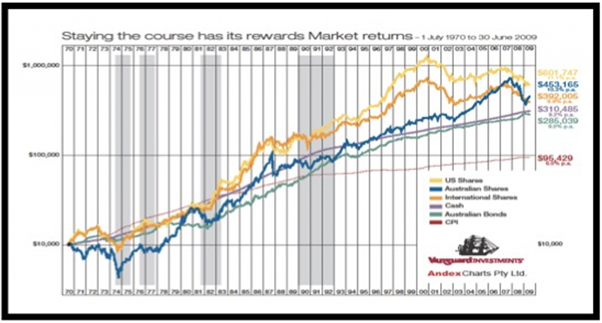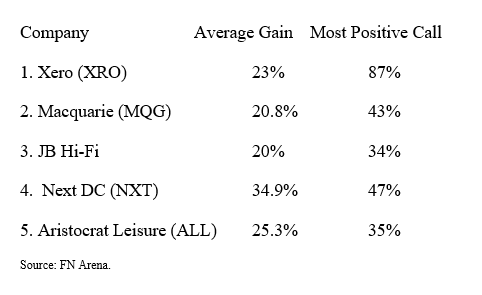Security Alert: Scam Text Messages
We’re aware that some nabtrade clients have received text messages claiming to be from [nabtrade securities], asking them to click a link to remove restrictions on their nabtrade account. Please be aware this is likely a scam. Do not click on any links in these messages. nabtrade will never ask you to click on a link via a text message to verify or unlock your account.
Switzer: Five lessons on how to play the long game
The year 2022 has been a bad year for stock market returns but a good one for investors to focus on the fundamentals of successful investing and wealth-building. And the loss lesson for the year might be harder if you’ve simply sat there and watched your portfolio diminish. But it’s not too late to employ some of the really smart investing lessons that history has taught us and the greats of stock-playing have shared with us over time.
After I share these insights with you I will make suggestions how you can play ‘catch up’ on your 2022 losses and come out on top for the years ahead. This is not advice but it certainly is education.
The starting point for this lesson is to contrast the first week in October with the experience of stocks over September. This chart directly below visually shows the story.
S&P/ASX 200

Source: nabtrade
Lesson 1
From September 13 to October 3, the S&P/ASX 200 Index lost a big 7.8%, which took the annual loss to about 15%! But then over October 4 and 5 the market rebounded 5.5%, which shows how quickly market sentiment can change. This story screams out the first lesson of an investor which is this: you must be a long-termer and not be too influenced by short-term stories and market gyrations.
Lesson 2
Next, you have to have a commitment to investing in quality companies/assets that have had a consistent track record of delivery. One of the best is the overall Australian stock market, where you’re actually investing in Australia’s best listed companies. And if you do it through an exchange traded fund (or ETF), then you get it on the cheap, along with a great level of diversification.
If you aren’t gifted with the brilliance of the Oracle of Omaha, Warren Buffett, in assessing the potential of individual companies, then an ETF or managed fund can be a smart way to play stocks.
On the subject of investing in Australia, this is my favourite chart that I use to show the value of believing in Aussie companies. It’s not up-to-date but the story it tells between 1970 and 2009 is a really instructive one for investors wanting to lift their game.

At times like these, I like to show clients this chart of the All Ords between 1970 and 2009, one year after the market crashed 50% because of the GFC. This shows $10,000 invested in 1970 in a portfolio similar to the All Ords, with dividends reinvested, roll over into $453,542.
Just look at the blue line (above chart) for the Aussie stock market over that time. See those deep blue V-shaped movements? They were crashes in 1974, 1987, the dotcom crash of 2000 and the GFC.
At those times, some people who were worried (like you might be now) sold out at the bottom and missed out on the big rebounds that followed. That means they lost twice — once on the way down and once again with the rebound.
Provided you’re invested in a good portfolio, your capital return over time rises and grows like that blue line at a rough rate of 10% per annum over a decade. You just have to keep the faith and be patient if you don’t think you’re a genius market-timer — and most of us aren’t!
Lesson 3
The next important lesson to learn from history is that stock markets tend to have two or three bad years in 10, but the great years more than trump the bad years. That’s why returns average around 10% per annum over a decade, and half of that return comes from dividends.
Looking at our past decade, 2015 was a negative year, and so was the 2020 Coronavirus crash year, which has now been followed by this 2022 big sell-off, with the US-based S&P500 down a whopping 21%, while the tech-Nasdaq has slumped 29.6%!
And while there’s talk of the Fed’s inflation-fighting interest rate rises causing a US recession, there are prospective, countervailing developments that could help both 2023 and 2024 be better years for stock players.
Like what? Try these 5 historical gems:
- The third and fourth years of a US Presidency is very positive for stocks.
- Economists are tipping interest rate cuts in the US for late 2023, but they could be more likely in 2024, which tend to be positive for stock prices.
- An end to the Ukraine war is likely over the next two years, which will be a plus for energy prices and lower inflation.
- The pandemic problem for supply chain obstacles which has pushed up inflation should be done and dusted, which has to help keep inflation from rising.
- Stock markets tend to rebound strongly out of crash or big sell-off as 2009, after the GFC crash and 2020-21 after the Coronavirus crash showed. After the dotcom crash 2000-2002, the S&P 500 rebounded 80% and around 24% in the first year out of the low point for the Index.
The 5.5% rise in the market over two days in the first week of October is a sneak preview of what will happen when the market is certain that central banks, and especially the Fed in the US, are beating inflation.
If you’re a thrill seeker, you’d buy on any dips or sell-offs on the basis that sooner rather than later good inflation numbers will show up and the stock market will rebound convincingly.
The more cautious investor would wait for a number of months of credible data showing inflation is falling then the uptrend would be your friend.
I’ve already nominated an ETF for the S&P/ASX 200, which could easily deliver a 10% plus gain along with dividends and franking credits that could add up to 16% upside.
An ETF for the S&P500 would also have potential for bigger gains because it has a bigger exposure to tech stocks that have been smashed in 2022 but are likely to head the charge up when share market sentiment turns around. I’d opt for a hedge version of such an ETF because I’d expect the Oz dollar to rise over the next couple of years.
My top 5 companies
Looking for quality plays I want to invest in top companies hurt by the rising interest rates and anti-growth company stance that has hurt stocks this year. I want companies where the analysts see big rises ahead but they have to be quality outfits. Here are my top 5 that have 20% gains predicted by the analysts surveyed by FNArena and are 100% blue chip businesses.

Inevitably, lesser quality companies that have been belted up seriously because they’re tech/growth operations, will see big rebounds in 2023-24, but these are more risky plays.
Companies such as Megaport (MP1) and Audinate (AD8) fall into this group. The analysts on average think MP1 has a 33.3% rise in share price ahead, but UBS thinks it could be 80%, while Citi suggests it would be more like 61%. Meanwhile AD8 is seen to have a 28.5% gain in the near future but as I’ve argued, these are riskier plays.
Two important points have to be made. Firstly it pays to invest long term. Secondly, buying quality companies when stock markets are into short-term madness and mayhem can be the right time to go long stocks.
As Warren Buffet once advised: “Be fearful when others are greedy, and greedy when others are fearful”. But only take this advice with first-class businesses.
All prices and analysis at 6 October 2022. This information was produced by Switzer Financial Group Pty Ltd (ABN 24 112 294 649), which is an Australian Financial Services Licensee (Licence No. 286 531This material is intended to provide general advice only. It has been prepared without having regard to or taking into account any particular investor’s objectives, financial situation and/or needs. All investors should therefore consider the appropriateness of the advice, in light of their own objectives, financial situation and/or needs, before acting on the advice. This article does not reflect the views of WealthHub Securities Limited.
